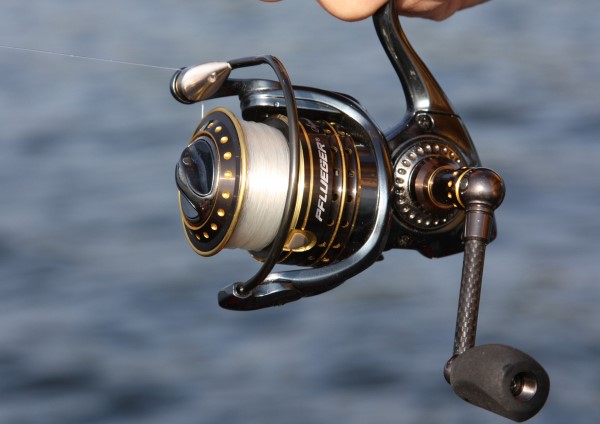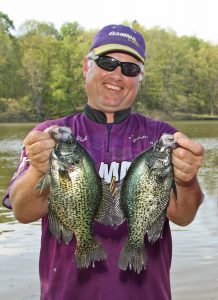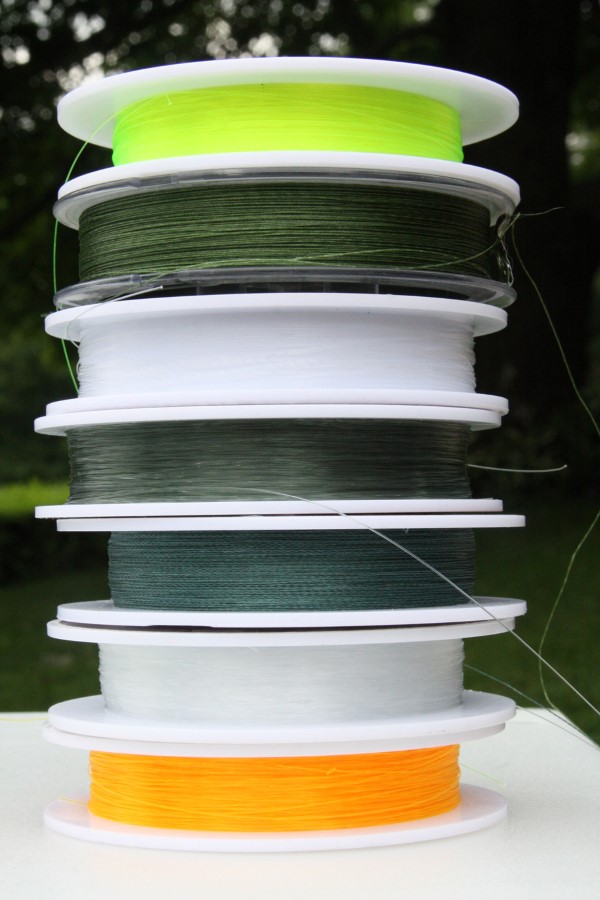Story & photos by Darl Black

The year was 1959 when Berkley’s Trilene and DuPont’s Stren were launched. Although there had been extruded nylon fishing lines prior to these two brands, both Trilene and Stren were far superior to anything else on the market. Nylon monofilament reigned supreme for approximately 30 years before fishing lines comprised of other materials found acceptance.
Today the marketplace offers several different types of line, each with specific characteristics that may or may not be beneficial to the crappie angler depending on what you desire in a fishing line. An excellent place to collect opinions on lines is at a gathering of crappie anglers, such as PA Crappie Camp held on Pymatuning Lake in NW Pennsylvania during May. However, before hearing opinions, we need to identify the types of lines out there.
The Lines
Monofilament is extruded from a single nylon base material. Copolymer is a blend of two nylon base materials to achieve certain characteristics.
Monofilament and copolymer are both a single strand extruded line, although a copolymer is usually viewed as an “improved” version of standard monofilament. Both lines have considerable stretch (good shock resistance), are buoyant and can be colored (i.e. green, orange, hi-vis, etc.).
Although it is an extruded line that looks like monofilament/copolymer line, fluorocarbon is not nylon; instead it made of carbon molecules. With greater density than nylon lines, fluorocarbon sinks. It also offers great abrasion resistance, has less elasticity than nylon, cannot be colored and is invisible in water.
Referred to as superlines in some circles, the third type of line is made from gel spun polyethylene fibers that are twisted or woven around one another. This line is commonly referred to as a “braid.” Some braids have a coating to make them slick. Braided lines are extremely strong for their diameter, exhibit basically zero stretch, have zero memory and float on water. However, they are not as abrasion resistant as either nylon or fluorocarbon lines.

The Opinions
Ken Smith is a long-time crappie angler with impressive credentials in educating anglers. Given that he is not a tournament angler, guide or pro angler representing a particular tackle company, Ken spends an incredible number of days fishing for crappies every year.
Ken uses one of two techniques all the time. He either: (a) casts light jigs or jig-bobber combo to visible cover; or (b) engages in Hang Gliding. Hang Gliding is an electronics-directed vertical slow-troll jig presentation which Ken developed on his home waters where the number of fishing rods is limited.
“I never use braid for crappie fishing. Don’t see the need to,” continues Ken. “My choices are very simple. For casting, I use a high visibility copolymer line of four or six-pound-test from Vicious, Mister Crappie or Gamma brands.
“Recently I’ve experimented with 2-pound Gamma Panfish for extremely light weight jig presentations. Yes, I do retie more often to avoid possible abrasion in the knot area, but if you need to go to a fine diameter line, this is the one to use.”
For his Hang-Gliding technique Ken employs 8-pound copolymer exclusively. “Hang-Gliding involves wrapping ½-ounce egg sinker directly on the line, with tag end forming an 18 to 24 inch leader from the sinker to 1/32-ounce jig. Then I lower it straight down so the sinker bumps around wood cover as I move the boat on the trolling motor. I lose a lot of jigs but also catch my share of crappies. Line rubbing the rough edge of a molded egg sinker will easily weaken a thin line; therefore I rely on thicker 8-pound nylon line.”
Having used nylon line for years to catch untold number of crappies, Ken sees no reason to switch to more expensive fluorocarbon or superlines.
Bryan Stuyvesant is a bass-chaser turned crappie angler, and one of the new high-tech anglers always looking into the latest advances in fishing equipment and line. “My crappie fishing includes casting jigs, bobber fishing and dock shooting. In these presentations, I incorporate all three types of lines – braid, fluorocarbon and mono – for various purposes.”
Bryan continues: “For casting jigs in shallow water, I use a B’n’M Sam Heaton 7’ spinning rod spooled with 10-pound Seaguar Smackdown – a slick finish braid – and a 6-pound test leader of Seaguar Invizx fluorocarbon. The coated braid allows super long casts while increasing sensitivity. The fluorocarbon leader makes sure crappies can’t see the line.”

His B’n’M Sharpshooter rod is spooled with the same braid and a short fluorocarbon leader, too. “That slick coated Smackdown comes off the spool smoothly and quickly – best line I’ve tried for dock shooting.”
Stuyvesant does a change-up on his longer and somewhat stiffer bobber rod. “I use stop-knots for slip-bobber fishing. The problem is stop-knots do not stay put on a slick coated braid. Therefore, I switch to a reel spooled with Trilene XL mono.
“That works great for open water bobber fishing, but in the early spring I’m fishing minnows under a bobber in the mats of last year’s vegetation and pads. Hook a pad stem when using monofilament line and you are going to break the line trying to get loose. So in this instance, I use an uncoated green colored braid straight to the hook.”
Stuyvesant purchased all the same model reels with extra spools for his crappie rods. In this way he can spool different types of lines on different spools and switch them out as needed. For example, when fishing jigs in deep water, Stuyvesant selects a spool of coated braid that is bright yellow in order to help him see light strikes easier.
Dale Black is a relatively recent convert to crappie fishing. After acquiring Gamma Fishing Line several years ago, crappie anglers said they really liked his regular copolymer line but what was needed was a high visibility line. The result is Gamma Panfish in Optic Yellow, now Dale’s favorite for drifting and bobber fishing.
“The North End of Pymatuning has several major stump fields. My favorite way to fish these areas is by drifting a jig under a light breeze – sometimes with a float, sometimes without. Either way, using high visibility 6-pound-test that floats rather than sinks, enables me to see the slightest line twitch indicating a bite.”
When casting or pitching a slip float-n-jig to weed or wood cover with his 10-foot B’n’M Russ Bailey Signature Rod, Dale uses high-vis copolymer. “With nylon-based line the stretch enables me to sling-shot the jig off a snag. You can’t do that with a no-stretch braid.”
On his deepwater jig rod, Dale spools six-pound fluorocarbon. “Fishing mid-depth or near the bottom with a jig calls for a line that sinks and that is extra sensitive – that’s fluorocarbon. Because this line sinks, the bow that often occurs in a floating nylon line is basically eliminated thereby increasing the efficiency of a hookset.”
“I don’t use braid in crappie fishing,” concludes Dale. “I know some anglers use braid for pulling crankbaits or long-lining, but those are not techniques I use.”
As you see, no one line fits all situations when it comes to crappie fishing. You need to evaluate the pros and cons of each type of line, give them a fair test, and only then arrive at the right line for your style of crappie fishing.











































